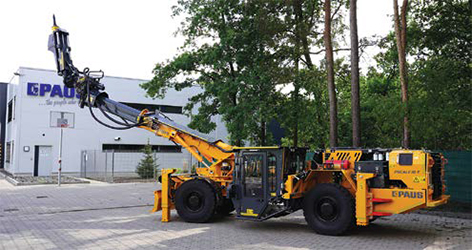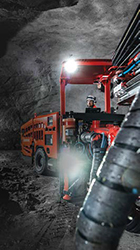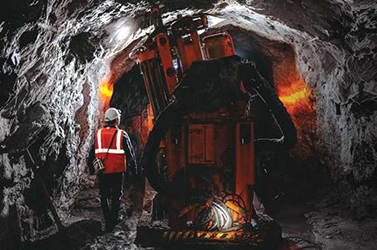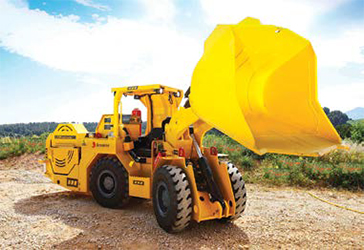
A ZB21 at the San Xavier student-training mine in Arizona. (Photo: Komatsu)
OEMs Announce New Narrow
Vein Solutions
New jumbos, a bolter, a scaler, and drill optimization tech seek to help miners
increase revenue and improve sustainability
By Jesse Morton, Technical Writer

The headlines show that advances in the space continue at a brisk clip as suppliers invest heavily in solutions that help customers increase revenue and meet sustainability goals.
Battery-powered Jumbo,
Bolter
Komatsu introduced the updated ZJ21
jumbo and ZB21 bolter, the second generation
of the Z2 product line. Enhancements
and additions include “the first
battery-electric offerings in Komatsu’s
underground hard rock portfolio and
an innovative pumpable resin system
solution, all designed to provide significant
benefits to mining operations,” said
Bradley Bell, product manager, underground
drills.
The jumbo and bolter are single-boom “mining rigs engineered to navigate headings down to 3- x 3-m while maintaining the capability to develop and support much larger tunnels,” he said. “Both models feature our exclusive blackline Montabert drifters.”
On both rigs “the battery is integral to the machine and does not require change-out for off-board charging,” Bell said. “Our BEV drills use opportunistic charging, leveraging the Joy soft rock legacy and experience of 100 years in mining machinery, which now includes electric-drive machinery,” he said. “Charging occurs seamlessly while drilling, meaning no downtime associated with energy replenishment.”
The charging system is designed to use “existing infrastructure in current operating mines, which offers significant benefits to greenfield operations and existing and operating mines that may not have the capital to redesign the entire electrical infrastructure underground for dedicated charging areas or battery swap sites,” he said. “Our battery drive rigs are dependable, rugged, highly efficient, and deliver outstanding performance.”
The resin-pump attachment system “creates a unique solution to an industry- wide challenge,” Bell said. Additionally, it “builds on our multi-tool approach to ground support.” The system “allows material to be pumped into the drilled hole prior to bolt installation,” he said. It uses Jennmar’s J LOK P resin and catalyst, an iso-cyanide- free, non-carcinogenic polyester chemistry. “Our unique approach to bulk resin permits using more economical bolt types relative to other bulk resin market offerings.”
Fully mechanized, the system “reduces the amount of labor-intensive handling when compared to cartridge-type resin, or more manual bolting methods,” he said. “It eliminates operator exposure to a high-risk zone when compared to more manual bolting methods.” The system delivers “superior alignment and accuracy,” Bell said. “It can help boost productivity, lower costs, and reduce cycle times.” Other benefits offered include reduced waste “due to an extended product shelf life.”
The rigs share platform designs. Common parts mean “fewer parts to stock, which reduces inventory costs and simplifies supply chain management,” Bell said. Common controls “streamline operator training between drilling and bolting and reduce the learning curve for new operators seeking dual qualification.” The common system design “eases maintenance training and improves maintainability through process consistency.” The ZB21 features integrated screen handling with a “simple and robust design, less moving parts, and improved visibility” over the predecessor bolter, he said.
Beyond performance, productivity and maintainability improvements over predecessor machines, the new battery- electric units offer “a significant opportunity to reduce environmental impact and promote a healthier workplace for miners,” Bell said. The bolter and jumbo “eliminate CO, NOX, and DPM emissions,” he said. They “consume no fuel, and generate less heat and noise than do conventional diesel machines.”
Emissions-free equipment requires less ventilation. “Emissions related to diesel-drive equipment have a direct relationship with ventilation requirements,” Bell said. “Lower emissions mean less ventilation and less ventilation means reduced capital costs.” Ground-level maintenance design features help speed and de-risk maintenance tasks.
Design work on the original Z2 series began in 2017 and ran into 2019. The series first launched in 2020. “From there, a growing global fleet continues to operate in multiple regions, with good customer acceptance,” Bell said. “Komatsu’s commitment to seeking carbon neutrality, along with a strong partnership with Jennmar, made it a logical next step to pull focus towards fleet electrification and innovative bulk resin solutions for our second generation launch in 2024.”
Prior to launch “a prototype battery drive rig has been tested extensively at the Komatsu Arizona Proving Grounds in Tucson,” he said. “This 270-ha facility, along with a nearby underground test mine, is known for bringing unique mining concepts to life.” Throughout, “we were able to exceed our internal expectations with regard to tramming performance and gradability,” Bell said.
During roughly the same period, “a prototype ZB21 unit fitted with our pumpable resin solution has been part of an underground trial with a Tier-1 miner in Sudbury, Ontario,” he said. “The trial has provided a unique opportunity to engage directly with the customer and work hand-in-hand to create value together.” Basically coinciding with the launch, Komatsu reported its “newly renovated 6,000-m2 jumbo and bolter production facility is designed for safety, quality, and efficiency while increasing production capacity.”
Paralleling those renovations, “we also renovated our 5,200-m2 underground hard rock center of excellence, which is dedicated to developing and evaluating equipment, people, and services that support the industry,” Bell said. “These world-class facilities demonstrate our investment in growth in underground space.”
Ultra-low-profile Scaler
Hermann Paus Maschinenfabrik said the
new PAUS PScale 10-T LP scaler is a
compact, robust and powerful solution for
narrow-vein mining operations.
“These machines are operated with
hydraulic hammers well suited for mining
and tunneling, and capable for use in hard
and soft rock applications,” said Hendrik
Hoernschemeyer, area sales manager,
mining and tunneling. Designed for tight
spaces “the new LP model features an
ultra-low-profile design with a machine
height of just 1.9 m.”
The model is based on predecessor scalers. It “comes with various changes to the machine design, but is just as compact and powerful,” Paus said. “It’s unique construction, coupled with generous cooling systems and a robust motor concept, ensures optimal performance in difficult conditions,” it said. “Making it perfect for low-clearance paths,” and enabling it to navigate through small galleries with ease. “But the PScale isn’t just about size,” the company said. “It’s about adaptability

The boom arm reaches to 10 m, and uses a manipulator capable of multi-axis rotation and tilt. The manipulator can come with a “355° rotary drive and 800-mm feed, which improves coverage at the sidewalls but also to scale at the most difficult areas to access, like between hanger assemblies of the conveyor belt system,” Hoernschemeyer said.
The scaler’s hydrostatic drive gives it the power to quickly change working locations. Like predecessor scalers, it has a 20° tiltable cabin, located in the middle of the machine. “The elevating cabin can be raised up to 500 mm,” Paus said. “It provides adaptability to any situation, better visibility, and more comfort.” The climate-controlled, vibrationdampened cabin is also adjustable in height for optimal clearance and “allowing operators an improved circumferential visibility during operation and when travelling through sections,” Hoernschemeyer said.
The scaler is driven by two joysticks. The ROPS- and FOPS-certified cabin has safety features that set the scaler apart from competitor models, he said. “Lots of machines are just providing a compromise for safe and economic handling in a mechanized way,” Hoernschemeyer said. “With the PScale series, Paus is not just following internal standards like the ISO 19296 for mobile machines working underground but also providing a more safe and also comfortable workplace for operators.”
Paus scalers are offered with optional plug-and-play remote control capability, Paus said. With it, “operators can work from a safe distance or vantage point, enhancing efficiency and security.” The 10-T LP Scaler was designed with accessibility and maintenance as top priorities, it said. “A hinged radiator provides quick access to vital components.” Topping the list of benefits offered is increased productivity. “Looking to standardized processes underground after the drilling and blasting, it is required to remove loose rock from the face to make the tunnel or mine safe to work in,” Hoernschemeyer said. “By providing a purpose-made machine in terms of agility and boom-reach, the PScale will reduce process times required for the scaling, which can reduce the time for a blasting round in general and can further improve the productivity of the mine.”
The scaler “can replace mechanized scaling processes in mines, which is currently being done with jumbos,” he said. “Comparing the machine costs per hour and taking into consideration the effect of machine availability, a dedicated and agile scaling machine can typically execute in a more economical way.” The 10-T LP can also help a miner attain sustainability goals. It is “offered with optional configuration with CE declaration for use in the European Economic Area,” Hoernschemeyer said. “This includes the latest engines and exhaust stages, EU Stage V and Tier 4-Final.”
The scaler was “developed based on an initial request from a client for a dedicated PScale-type featuring the proven characteristics of the PScale 10-T, but that can also travel tunnel sections with very limited heights,” he said. “Within just 12 months, Paus developed, manufactured and tested the new variant.”
The first unit, “following intensive and successful testing at our specific test stand for scalers, just passed FAT and is going to be shipped within upcoming days,” Hoernschemeyer said. It will be “delivered to a salt mine in Germany at the end of May,” Paus said. The 10-T LP adds to the supplier’s proven range of narrow-vein solutions. That range includes the Uni 40, MinCa 5.1 and 18, PMK 10.000, PFL 8 and 10, TSL 853. “All these machines are designed for use in difficult and small environments,” the supplier said.
It is also an “example of customized and purpose-made underground equipment,” Hoernschemeyer said. “PAUS is always seeking solutions that best suit the application of our clients.”
‘Intelligent’ Drilling Solution
Sandvik is set to introduce a new drilling
solution for narrow vein mining in October,
adding to their extensive range of
“intelligent” iSeries drills.
The solution answers a trending shift
to intelligent drilling driven by the need for
more productivity, improved drilling accuracy,
more advance meters, reduced
costs, and better overall performance
in narrow vein operations, an expert at
Sandvik said.
“New technology features expected in Sandvik’s forthcoming offering include an advanced drilling control system, one-hole to full-face automation, a more advanced and ergonomic operator interface, onboard diagnostics, and scalable automation packages from Silver to Platinum levels,” said Jean-Christophe Goiffon, low-profile and narrow-vein product manager, Underground Drilling Division. “This will enable maximizing profitability through more tons per blast and more blasts per day, minimizing the cost per ton through drilling quality,” he said. “It will also minimize overbreak and maximize pull-out through comprehensive drill planning, data reporting, and analyzing tools for process optimization.”

“Additionally, our 2024 offering will include options for Tier 3 and Stage V engines, helping our customers in their process to cleaner operations,” Goiffon said. Final hurdles are being cleared now, setting the stage for the official release after MINExpo. “We have been conducting operator training at Sandvik’s Factory in Lyon, France, for the new narrow-vein offering with very positive feedback,” he said. “Several technicians from Mexico and Peru have completed training via the new Digital Driller training simulator, which ensures they are prepared for the arrival of new narrow vein drills to their local operations.”
Sandvik representatives supporting operator training on site in key markets report a high level of operator acceptance “due to the easy transition to the new equipment,” Sandvik said. “The simulator uses authentic controls and the same control system software as the ones on Sandvik machines, allowing operators to develop their skill in a short period.” The machine is currently being tested in the field in Europe with “very positive feedback and showing its potential for improved productivity,” the supplier said. “The size and productivity of the new offering will answer exact customer needs in key markets such as South and Central America, the North Americas, Australia and Europe.”
OEM-agnostic Drilling
Optimization
Since acquiring Minnovare in January
2022, Hexagon has integrated the Drill
Optimisation suite with other workflows,
including task management. “This integration
gives Hexagon customers a continuous
workflow, improving efficiency,”
said Andrew Clark, mining product manager,
operations, Hexagon.
Hexagon also expanded the capabilities of Production Optimiser to address the requirements of customers in Latin America, North America and South Africa. “New features have been introduced to better suit operational practices, workflows and rigs used in those regions,” said Hector Parra, mining product manager, drilling, Hexagon. “For instance, the hardware’s design has been improved to withstand buggy rigs’ more demanding vibration conditions,” Parra said. The system also now supports up to four shifts per day, and the app and web platform were translated into Portuguese and Spanish. “We have also extended the toolset used by our technical support team to proactively advise customers worldwide on how to extract the most benefit from the solution.”

In seven site trials, Development Optimiser achieved a “significant reduction in the operations’ development overbreak and underbreak,” said Tom Boylson, mining commercial director, underground. “Across the seven trials, there was a 44.3% reduction to overbreak, with some sites also reducing their underbreak up to 77.7%,” Boylson said. “Fillets, crosscuts and turns all recorded a rapid decrease in overbreak, and safety improvements were noted due to operators not having to jump out of the cab to line up during these complex cuts.”
The jumbo operators’ testimony showed the solution attains key objectives. “Easy to use, easy to learn. Cuts come out excellent,” said a jumbo operator after the second trial. “I am now confident with burn holes that are really close together and don’t cross over.” After the sixth trial, a jumbo operator said the solution offers numerous benefits. “Setting up off only the center line saves time; not having to jump in and out of the cab during a 90-degree cut is great and makes it safer around a jumbo,” another operator said. When “drilling the backs, I don’t have to jump out and go to the back of the rig to check my angles,” another operator said. “I could see the system reducing fatigue, as it reduces the need to constantly jump in and out.”
Further integration will address trending challenges in underground production drilling. “At Hexagon, we understand that as mines push deeper for economic deposits, operating margins are becoming pressured,” Parra said. “We are working to develop a fully integrated ecosystem with a single point of entry to interact with our technologies on site and in the office, through a single onboard device and a unique web-based platform, respectively,” he said. “Our goal is to provide customers with real-time data to ensure operational performance and valuable insight to inform strategic decision making.”
Separately, for MINExpo, Hexagon plans interactive experiences and product demonstrations. It will showcase customer stories, case studies, and expert presentations at a 650-m2 booth in the West Hall, the supplier reported. “Our mining experts across all mining workflows will be on location to speak with attendees who want to learn more about any of Hexagon’s life-of-mine solutions.”
Solutions for Sustainable Underground Mining
By Marc Melkonian.
Historically, the mining sector has been blamed for impacting
the environment, including for high levels of carbon emissions.
Yet, paradoxically, mining is essential to the ecological transition,
to which most countries are now committed.
In Europe, for example, combustion vehicles will no longer be
allowed on the market from 2035 onwards, creating great prospects
for electric vehicle suppliers. At the moment, the need for
lithium to meet this growing demand is, therefore, considerable;
and numerous projects to exploit lithium deposits are underway.
Other minerals may well replace lithium in the next generation of
batteries. Various metals are also essential. Copper, for example,
is used to manufacture wind turbines and solar panels.
The extraction of strategic metals and minerals is therefore
essential to the current ecological transition. But can we also
operate underground mines sustainably? Even before ESG
concerns became the major issues du jour, Aramine championed
them for many years. The aim was, and continues to be,
not only to offer products that reduce the carbon footprint of
mines, but also to meet societal obligations, by improving the
working conditions of operators.
From Electric to Battery-powered Loaders
The first solution was to offer a low-carbon alternative to diesel-
powered machines. Around 20 years ago, Aramine marketed
its first electric loader. The machine was connected to the
power grid via a long, strong cable. The arrangement considerably
reduced CO2 emissions in the mine. Operators could now
enjoy better working conditions with quieter, emissions-free,
vibration-free machines offering the same performance as their
diesel counterparts.
Aramine’s engineers then quickly took the next step: Designing
a battery-powered electric machine. It would no longer be
permanently connected by a cable, which can sometimes cause
safety problems depending on the configuration of the mine.
This is how the L140B loader came to market in 2016, with
an innovation specific to Aramine, an energy module located
at the rear that houses the batteries and charger. It can be detached
from the machine at almost any point in the mine.
This makes the L140B the only electric mining vehicle that
requires no permanent infrastructure. In addition, an L140B,
with two energy modules, offers nearly unlimited range, as one
energy module operates for 4 hours, which is as long as it takes
to recharge. These technologies have convinced many customers
to convert their diesel fleets year after year.

Use of Renewable Energies
The use of battery-powered vehicles helps solve the problem of
diesel supply in isolated mines. But electricity can also be difficult
to deliver. Renewable energies are then the ideal solution.
Aramine has recently been offering its customers the installation
of a solar station kit, to be assembled on site. The solar
panels produce enough electricity to recharge the L140B’s batteries,
while also ensuring the mine’s power supply to a greater
extent, depending on its size.
Thus, customers located in areas with lots of sunshine benefit
from permanent access to electricity without the risk of outages,
and this represents a more economical and responsible
means of access to electricity.
Battery Recycling
The batteries of Aramine’s electric machines are sufficiently efficient
to ensure optimal performance over a lifespan of more
than 8,000 hours of use. After that, expired battery reuse appears
to be an option. One possibility considered is allowing
isolated schools in developing countries to use the batteries.
Aramine teams are actively exploring this and other options.
Marc Melkonian is the CEO for Aramine.